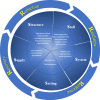A practice-based nursing emergency management system model for public health emergencies: A descriptive qualitative study
- PMID: 36747470
- PMCID: PMC10170909
- DOI: 10.1002/nop2.1635
A practice-based nursing emergency management system model for public health emergencies: A descriptive qualitative study
Abstract
Aim: This study aims to explore nursing emergency management system under public health emergencies.
Design: A descriptive qualitative study.
Method: Semi-structured interviews were conducted during March-November 2020 with 11 nursing emergency management administrators from 11 COVID-19 designated hospitals and infectious disease hospitals under four administrative divisions in China, who were recruited through convenience and purposive sampling. Interviews were audio-recorded and transcribed. Data were analysed with Braun and Clarke's inductive thematic analysis. The study adhered to the Consolidated Criteria for Reporting Qualitative Research.
Results: Three main themes emerged from data analysis: (1) Five core elements of nursing emergency management system: Structure, Staff, System, Setting, and Supply (5S); (2) Four phases of nursing emergency management system: Reduction, Readiness, Response and Recovery (4R); and (3) operational process of nursing emergency management system (5S*4R). The findings generated a conceptual model of a nursing emergency management system.
Public contribution: This study provides a theoretical basis for nursing emergency management system for public health emergencies in the future. Nurse administrators could refer to this model to either review or develop their system and develop viable interventions to prepare for future public health emergencies.
Keywords: COVID-19; nursing emergency management; public health emergency; qualitative study.
© 2023 The Authors. Nursing Open published by John Wiley & Sons Ltd.
Conflict of interest statement
All authors declare no conflicts of interest.
Figures
Similar articles
-
Nurse Managers' Experiences in Organisational Adaptation During Public Health Emergencies: A Qualitative Study.J Adv Nurs. 2025 Jul;81(7):4172-4186. doi: 10.1111/jan.16626. Epub 2024 Nov 13. J Adv Nurs. 2025. PMID: 39535292
-
"Their tenacity to just keep going": Nurses' experiences in medical hotel quarantine during the COVID-19 pandemic.J Adv Nurs. 2023 Nov;79(11):4280-4291. doi: 10.1111/jan.15758. Epub 2023 Jul 3. J Adv Nurs. 2023. PMID: 37395435
-
Qualitative study on the core competencies of nursing personnel in emergency medical rescue teams at comprehensive hospitals in Chongqing, China.BMJ Open. 2024 Apr 10;14(4):e077821. doi: 10.1136/bmjopen-2023-077821. BMJ Open. 2024. PMID: 38604634 Free PMC article.
-
Status and Challenges of Public Health Emergency Management in China Related to COVID-19.Front Public Health. 2020 May 29;8:250. doi: 10.3389/fpubh.2020.00250. eCollection 2020. Front Public Health. 2020. PMID: 32574311 Free PMC article. Review.
-
The Role of Public Health Emergency Management in Biodefense: A COVID-19 Case Study.Disaster Med Public Health Prep. 2022 May 2;17:e185. doi: 10.1017/dmp.2022.113. Disaster Med Public Health Prep. 2022. PMID: 35492020 Free PMC article. Review.
Cited by
-
Urban residents' self-rescue in response to public health emergencies in China: a qualitative study.BMC Public Health. 2023 Dec 16;23(1):2520. doi: 10.1186/s12889-023-17442-5. BMC Public Health. 2023. PMID: 38104101 Free PMC article.
References
-
- Adams, L. M. (2009). Exploring the concept of surge capacity. Online Journal Issues Nursing, 14(2). 10.3912/OJIN.Vol14No02PPT03 - DOI
-
- All About People . (2017). The 4R's of Emergency Management . https://www.allaboutpeople.co.nz/wp‐content/uploads/2017/05/The‐4Rs‐of‐E...
Publication types
MeSH terms
LinkOut - more resources
Full Text Sources
Medical


